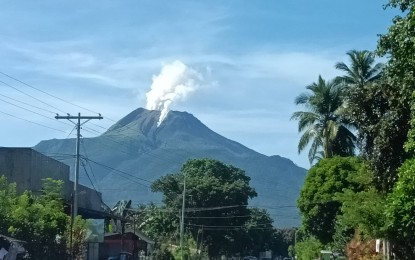
(PNA file photo)
MANILA -- An increase in seismic activity has been observed in Mount Bulusan in Sorsogon province.
The Philippine Institute of Volcanology and Seismology (Phivolcs) on Friday said Mount Bulusan generated 149 volcanic earthquakes in the past 24 hours.
Late Thursday, Phivolcs said 45 volcanic quakes, including two low-frequency volcanic quakes, have been recorded from 5 a.m. to 11:20 p.m.
While most of these earthquakes were weak and shallow, Phivolcs Director Renato Solidum Jr. confirmed that the increased number of volcanic quakes may indicate that a phreatic eruption could possibly occur.
Volcanic earthquakes are caused by movements or eruptions of magma from the volcano. Phreatic eruptions, on the other hand, occur due to shallow hydrothermal activity.
Meanwhile, 24 tons of sulfur dioxide emission was recorded on June 9. Moderate plume emission 100 meters high was also recorded.
Volcanic plumes are columns of hot volcanic ash and gas emitted into the atmosphere during an explosive volcanic eruption. A weaker eruption is based on the height of the plume coming out of the crater.
Alert Level 1 (low-level unrest) is maintained over Mount Bulusan.
Entry into the 4-kilometer radius permanent danger zone (PDZ) must be strictly prohibited, and vigilance in the 2-kilometer extended danger zone on the southeast sector must be exercised due to the increased possibilities of sudden and hazardous phreatic eruptions.
Pilots are advised to avoid flying close to the volcano’s summit as ash from a sudden phreatic eruption can be hazardous to aircraft.
Phivolcs also urge people living within valleys and along river or stream channels, especially on the southeast, southwest, and northwest sector of the edifice, to be vigilant against sediment-laden stream flows and lahars in the event of heavy and prolonged rainfall should a phreatic eruption occur.
A volcano's alert level is being determined depending on the number and type of earthquakes recorded, including the location, depth, and energy of the tremors.
Other parameters, such as ground deformation, the chemistry of gases and water, and surface manifestations are also being considered. (PNA)
